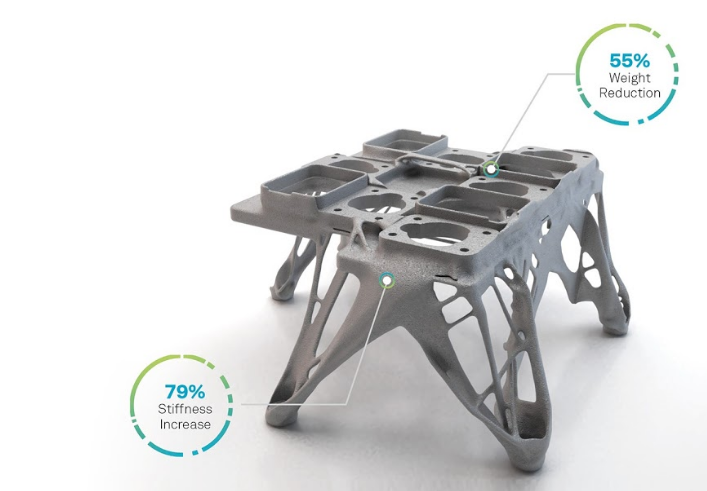MSC Software (a subsidiary of Hexagon, the publicly-traded Swedish tech giant with a market cap of $21.6 billion), known worldwide for their simulation software (including for AM), has just announced the release of a generative design tool allowing users to create highly-optimized, print-ready designs from a typical laptop. Not only that, they can do so 80 percent faster. MSC Apex Generative Design 2020 is capable of producing “optimal structures,” requiring only mechanical stress and size for production. Only viable parts are printed, with time and money saved on the bottom line due to a lack of quality or overall failure.
“To be more cost efficient, a redesign was absolutely necessary,” states MSC Software customer Dr. Martin, Laher MIBA Sinter Austria. “With MSC Apex Generative Design 2020, we were able to show that printing time and costs can be significantly reduced with a volume reduction so that we are now much more competitive.”
Products can be 3D printed with lighter weight, less waste in materials, and less time regarding labor too as the designer or engineer is free to engage in other work rather than wasting time in reproduction of parts that failed. With the new software, parts are ‘fine-tuned’ and ready for manufacturing.
MSC Apex Generative Design 2020 is suitable for almost all applications, saving users a staggering 80 percent in design time. Surgeons can create medical devices like implants, ‘pre-validating’ their designs for 3D printing, along with improving biocompatibility and mimicking the identical weight and structure of tissues like bone. Engineers can redesign parts with lighter weight, yet with better efficiency in functionality, and equal performance and safety.
Automotive engineers can build products for vehicles like motorcycles, designing chassis that are over 50 percent lighter—able to save on energy consumption and reduce the environmental footprint. Manufacturers overall can take advantage of ‘first-time-right part production.’
“Designing an optimal product that fully exploits the available techniques is such a convoluted process today, that designers have to compromise. Designers’ eyes light up when they use MSC Apex Generative Design because it thinks like them, improving parts with intelligent engineering decisions – only much faster,” said Thomas Reiher, Director of Generative Design, MSC Software.
“Our users have reported slashing their design time by 80% by reducing the number of individual tools and interventions, automating the optimisation process, and streamlining their workflows. They start producing products that for the first time they have been able to optimise with design, performance and cost all tailored to their technical and commercial requirements.”
The software also offers the following features:
- Generation of the first designs in an hour
- Production of final design within hours
- Intuitive interface tool for designers without specialized knowledge
- Anticipation of design issues
- Design for Additive Manufacturing (DfAM) tool for topology optimization and smoothing
- Linking to other tools like Simufact Additive for metal and Digimat AM for polymers
“This first major release introduces new controls that make it easier for designers to adjust the complexity of the generated designs and how much the fixation points can be reduced,” states the MSC Software team in a recent press release sent to 3DPrint.com. “It also exploits many productivity benefits of the underlying MSC Apex platform, for example direct export of engineered models (mesh) to Computer Aided Design (CAD) formats so that generative design optimisation can be used within common CAD/CAM manufacturing workflows.”
This software release joins a host of other generative design tools being used for additive manufacturing and 3D printing, to include those created by companies like nTopology, allowing users to design complex structures quickly. Netfabb from Autodesk offers end-to-end solutions for users, while companies like Colorado’s Frustum (owned by leader in CAD—PTC) specializes in artificial intelligence software and cloud-based topology optimization solutions with products like TrueSolid.
[Source / Images: MSC Software]Subscribe to Our Email Newsletter
Stay up-to-date on all the latest news from the 3D printing industry and receive information and offers from third party vendors.
You May Also Like
3D Printing Webinar and Event Roundup: April 28, 2024
In this week’s 3D Printing Webinar and Event Roundup, the Ceramics Expo is taking place in Michigan, Stratasys continues its advanced training courses, and SPE is holding a Polymer Characterization...
3DPOD Episode 196: Bioprinting and Biofabrication with Dietmar Hutmacher, Queensland University of Technology
Dietmar Hutmacher is a Professor and Chair in Regenerative Medicine at the Faculty of Engineering, School of Mechanical, Medical, and Process Engineering at Queensland University of Technology. He possesses extensive...
3DPOD Episode 195: 3D Printing Wood, Coffee, and Seaweed with Andy Jeffery, Marvel Labs
Andy Jeffery is a long-time 3D printing veteran who has repeatedly introduced binder jetting technologies to new areas. Starting as one of the earliest adopters of this technology for filters,...
3DPOD Episode 194: Product Design and the Additive Journey with PADT Hardware Director David Dietrich
David Dietrich‘s journey in 3D printing spans from materials engineering roles at Boeing and ORNL to his position as an engineering fellow at Honeywell, showcasing his extensive experience in metals...

































